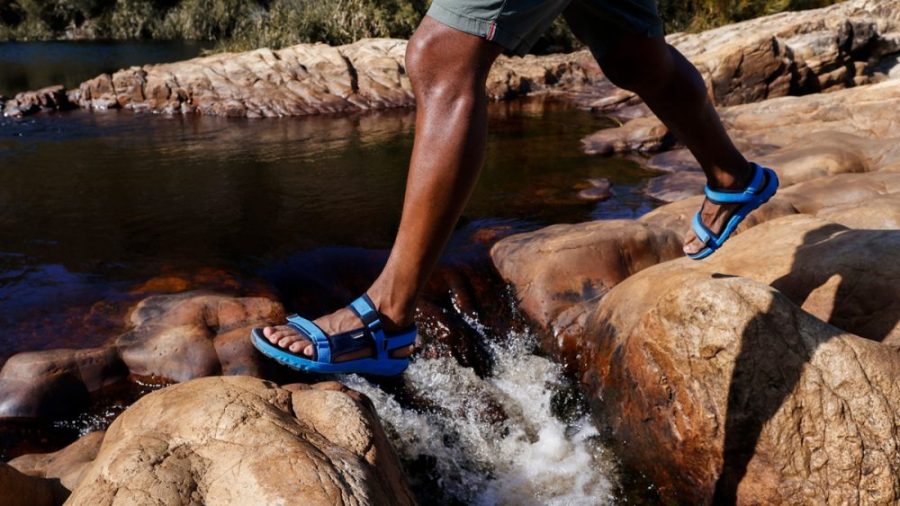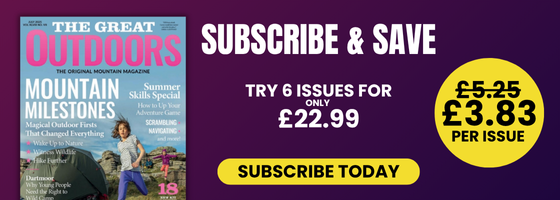Sandals have been worn for virtually all of human history, but it’s only as recently as the 1960s when this form of footwear became designed for the specific act of hiking. Nowadays, specialist boot and shoemakers have developed technology and fit innovations to bring you the best hiking sandals fit for purpose.
The modern hiking sandal as we know it can arguably be attributed to the German brand Birkenstock. In 1964, they released a sandal which featured a contoured footbed designed to provide better support and comfort to the wearer and, although it was initially popularised as casual footwear, many outdoor enthusiasts started using this for hiking and camping due to its comfort and functionality over uneven terrain. In the following decades, other footwear companies also began to produce specialised hiking sandals, most notably Teva and Chacos and as outdoor recreation gained popularity, hiking sandals became more mainstream.
Today, numerous brands offer hiking sandals with advanced features, catering to different types of terrain and outdoor pursuits and you can find sandals designed for anything from light trail hiking or basecamp use through to long-distance trekking.
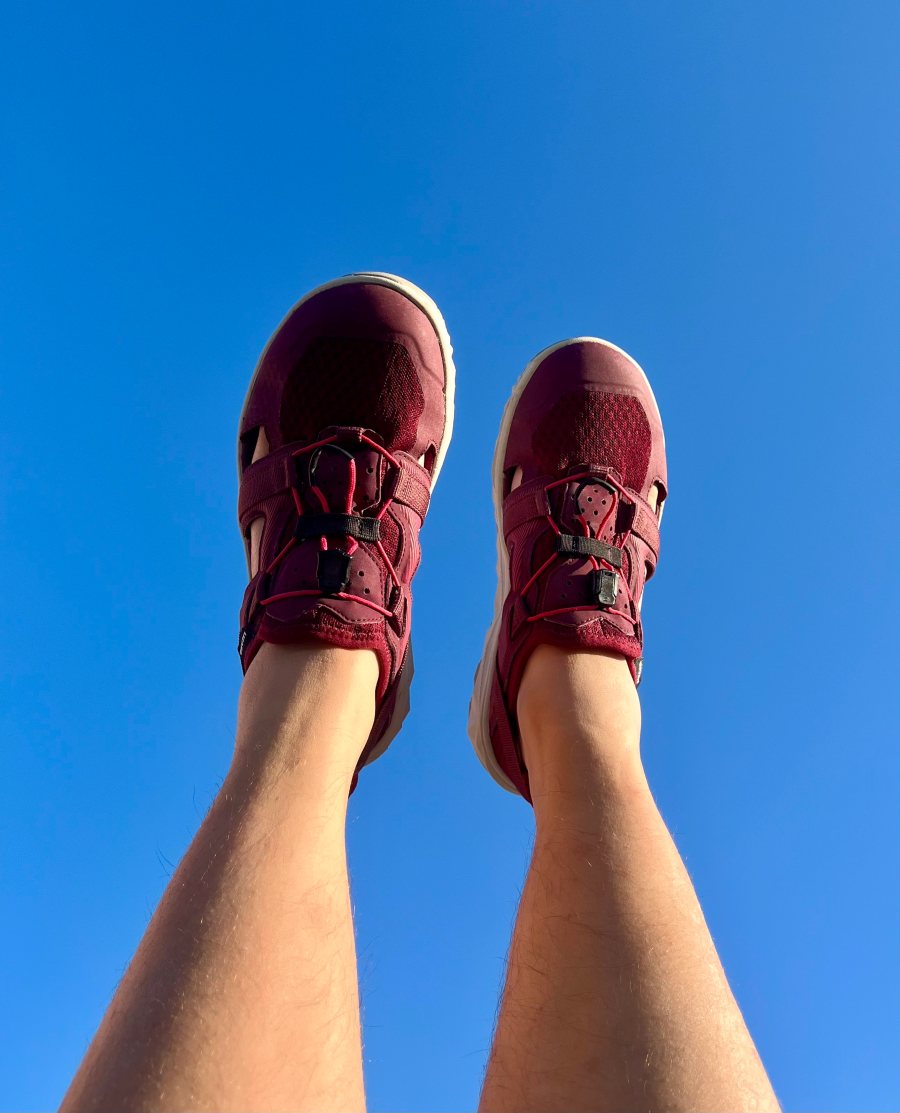
Hiking sandals aren’t universally appreciated, however. Some people prefer the support, stability and protection of a trail shoe or hiking boot. I personally am a big fan of hiking sandals and I’ve worn a lot of different models and hiked hundreds of miles in them. I won’t wear them for every hike but on hikes that I know that they’ll be the most comfortable option for me; so any trips where I’m going to benefit from the maximum breathability and ventilation sandals can provide.
In warm weather sandals can be the ideal walking footwear, even on longer distance hikes with a big pack. In sandals your feet stay cool and dry quickly if wet. Feet toughen up too, unlike in sweaty socks and damp shoes or boots when they can soften and blister easily. There’s a perception that sandals are only suitable for maintained paths. That’s not so. They can be worn on steep, rocky terrain with no problems. Of course, in some sandals toes are more exposed, but only a little more than in trail shoes. Boot wearers may take a little while longer to adjust to sandals.
For walking on rough terrain, sandals need a sole with a good grip and straps that keep them securely on your feet. Good cushioning is worth having too, especially for longer walks. Sandals also expose your feet to sunshine and biting insects so sunscreen and repellent needs to be applied to them. In prolonged hot dry weather cracks can appear in your skin, especially round the toes. Sunscreen or a moisturiser can ease these.
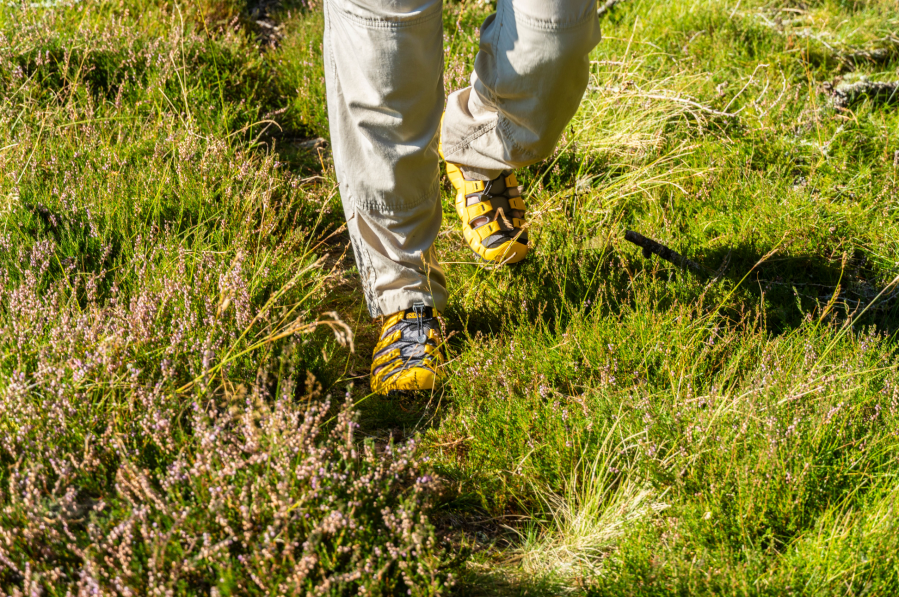
Grit and other debris can get trapped under your feet. With open-toed sandals just tapping the toe on the ground is usually enough to shift this, which is why I prefer this style. Closed-toe sandals have to be taken off. If it’s cold enough to need socks when walking, I prefer trail shoes to sandals as socks quickly get dirty and torn in the latter. It’s much easier to wash and repair your feet!
However, at camp socks in sandals can be useful on cool evenings (it’s not a fashion parade). Sandals are great for stream fords too. Just walk through the water. There’s no need to take them off. Wet sandals dry quickly.
Why you can trust The Great Outdoors
The Great Outdoors is here to help you make the most of your time outside. We have been helping people to explore from sea to summit, valley to mountain top for over 40 years. Our gear tests remain completely impartial. If you are wary of websites that only review brands that advertise with them, or sceptical of social media accounts always singing the praises of their latest freebie, you’ve come to the right place! Our reviews rank #1 for rigour, trustworthiness, and independence, and our gear testing team is the most experienced in Britain. With over 200 years’ experience between us, we are professional mountain leaders and instructors, wildlife photographers and rangers, outdoor authors, guidebook writers and trail addicts.
The best hiking sandals we’ve tested
| Quick List |
|---|
| Best in Test (women’s): Bedrock Sandals Cairn Evo Pro (available from Bedrock Sandals) |
| Best in Test (men’s): Columbia Trailstorm Hiker 2 Strap (available from Columbia) |
| Best for protection: Keen Hyperport 2 (available from Ellis Brigham) |
| Lightest in test: Keen Leiki Open-toe (available from SportsShoes.com) |
| Best for narrow feet: Lizard Ultra Trek (available from Outdoor Action) |
Best in Test for Women & Best Value
Bedrock Sandals Cairn Evo Pro
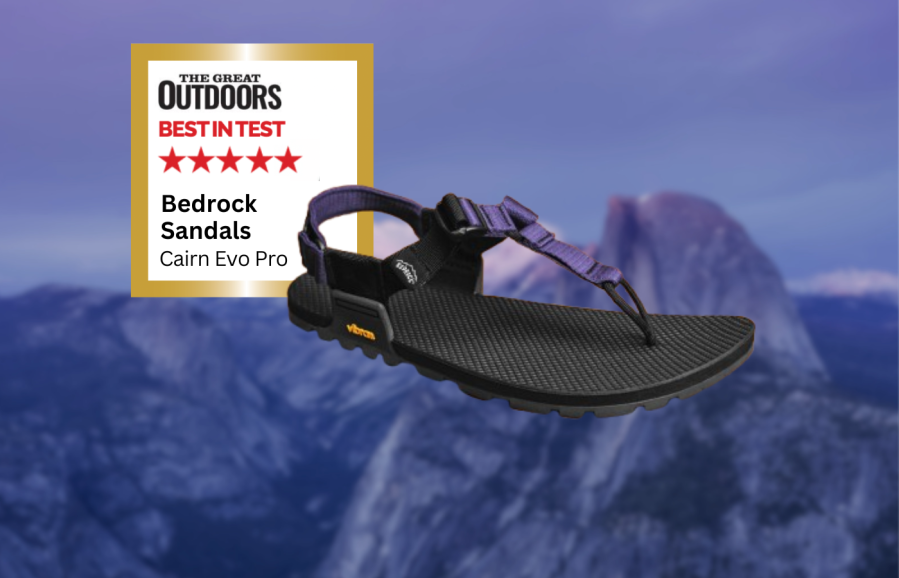
Kirsty Pallas’ Best in Test and Best Value
These have been my go to footwear for whatever I’m doing in warmer weather.- Comfort
- Good sole
- Adjustment options
- Weight
| Quick Specs | |
|---|---|
| Price: $136 / £102.34 Weight: 472g (UK size 5) Materials: Upper – premium polyester and nylon webbing, Outsole – Vibram megagrip, Footbed – EVA foam Features: Hook and loop strap adjustment, minimalist footbed Heel-to-toe drop: 0mm Lug depth: 3mm Waterproof: No Sizes: UK 4-13, EU 37-48 Women/Mens version: Unisex bedrocksandals.com |
Bedrock Sandals are a US company born from river restoration and looking for a hardy but comfortable sandal to work in, and these feel very well refined and tested. There’s obviously a lot of thought and time gone into the design of the Bedrock Sandals Cairn Evo Pro, giving me no option but to award them five stars.
The Cairn range of sandals use a toe post model, which is a piece of cord between the big toe and second toe, which keeps your feet in place really well on steep terrain. The sole unit is a well lugged Vibram Megagrip, which I’ve found really dextrous and confidence inspiring, with a smoother section at the toe to grip rock better.
It’s a fairly solid sole, and is where most of the weight lies, but it feels light when wearing and yet very protective. All of the Bedrock sandal models are zero drop, however some have a 3D moulded footbed which offers arch support and a refined toe triangle, but I chose a minimalist footbed. It still feels very comfortable and supportive enough but I’m used to barefoot style boots and shoes for a lot of my walking. It also gives a good ground feel, and means I get a sense of what I’m walking over which I enjoy.
Read more: Kirsty’s full review of the Bedrock Sandals Cairn Evo Pro sandals
Best in Test for Men & Best Value
Columbia Trailstorm Hiker 2 Strap
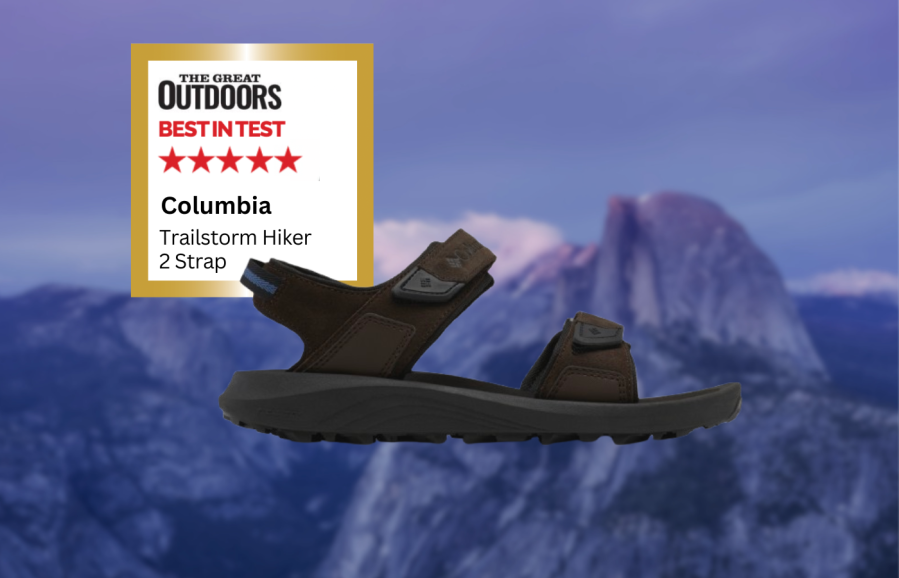
Chris Townsend’s Best in Test & Best Value
Minimal foot coverage, easy adjustment, secure, good cushioning, excellent grip. I can’t ask for more.- Simple design
- Cushioning
- Grip
- Weight
- Cost
- None
| Quick Specs | |
|---|---|
| Price: $86 / £65 Weight: 564g (UK size 9) Materials: Suede and synthetic leather upper, POE (polyolefin elastomer) midsole, rubber outsole Features: Two hook-and-loop closures Heel-to-toe drop: 15mm Lug depth: 6mm Sizes: UK men 6-14, women 3-10 Women/Mens version: Yes columbiasportswear.co.uk |
My preference in sandals is for minimalist designs that expose as much of my feet to the air as possible, which I think is the point of sandals. The Columbia Trailstorm Hiker 2 Strap sandals fit the bill exactly. There are just two adjustable straps, which is enough to hold your feet securely without covering anymore skin than necessary. The straps are quite long and the sandals fit my wide feet. The uppers are lined with a soft slightly spongey material that feels pleasant against the skin.
The footbed is soft and comfortable. The edges are slightly raised to help keep your foot in place. The sole curves up at the toe to give a little protection. The midsole is thick, soft, and effective. It has an antimicrobial treatment.
The outsole has the deepest tread of the sandals tested and the lugs are widely spaced which prevents them clogging with mud. The grip is excellent on a wide variety of terrain from wet rocks and grass to loose, dry gravel. The sole flexes easily at the forefoot but is a bit stiffer longitudinally, which helps stop it twisting under your foot on rough terrain.
Read more: Chris’ full review of the Columbia Trailstorm Hiker 2 Strap sandals
Keen Leiki Open-toe
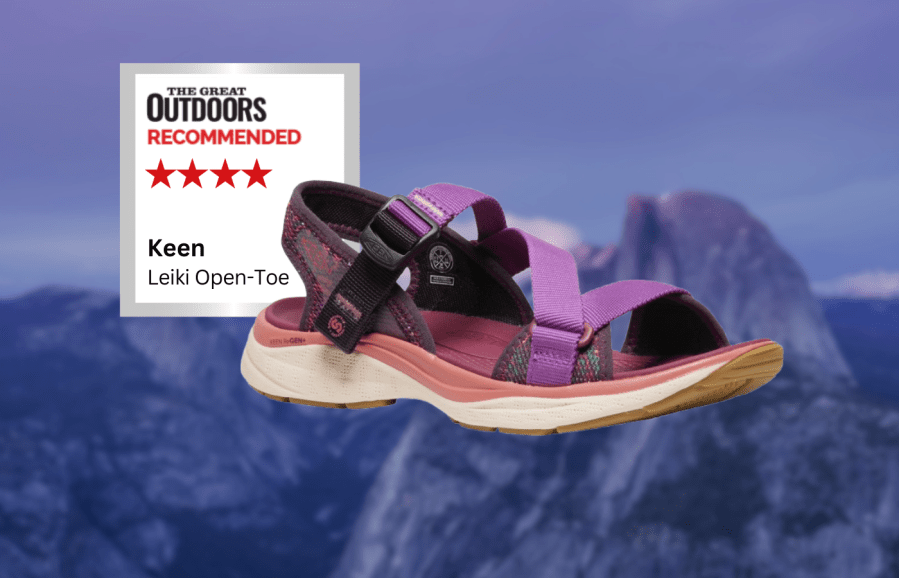
Kirsty Pallas recommends
There’s a few good features for long term use, like anti-odour in the foot bed, and being able to wash them in a machine.- Weight
- Women’s specific fit
- Long for size
- Non-adjustable heel strap
| Quick Specs | |
|---|---|
| Price: $120 / £90 Weight: 412g (UK size 5) Materials: Upper – polyester webbing, Outsole – Aquagrip rubber, Footbed – EVA foam Features: Padded heel strap, eco anti-odor footbed, contains recycled plastic Heel-to-toe drop: 8mm Lug depth: 2-3mm Waterproof: No Sizes: UK 2.5-9.5 including half sizes, EU 35 – 44 Women/Mens version: No keenfootwear.co.uk |
The Keen Leiki Open-toe sandal is a women’s specific model from Keen, and a breakaway from their traditional closed toe models. It’s a cross foot strap model which gives options for adjustment, while still a simple entry. Of all three sandals in the test, these have the least aggressive lugs, and while I didn’t slip in them, I would be slightly more wary using them in mud or on wet grass. The rubber is good and grippy on rock, and it works well on wet rock too, plus it’s non marking, so ideal for a boat holiday!
The footbed is well cushioned and the sandal utilises Keen’s Regen technology, which provides a bit of rebound from the midsole to decrease the energy you need to use. It’s moulded with arch support, however definitely suits a narrower foot as I didn’t feel like my feet could fully spread out.
The cross foot strap just has one buckle for adjusting, but this generally works well for allowing a wider fit in some areas and tightening up in others. It’s also fairly straightforward to use and you can easily take them off with one hand.
Read more: Kirsty’s full review of the Keen Leiki Open-toe sandal
Keen Hyperport 2
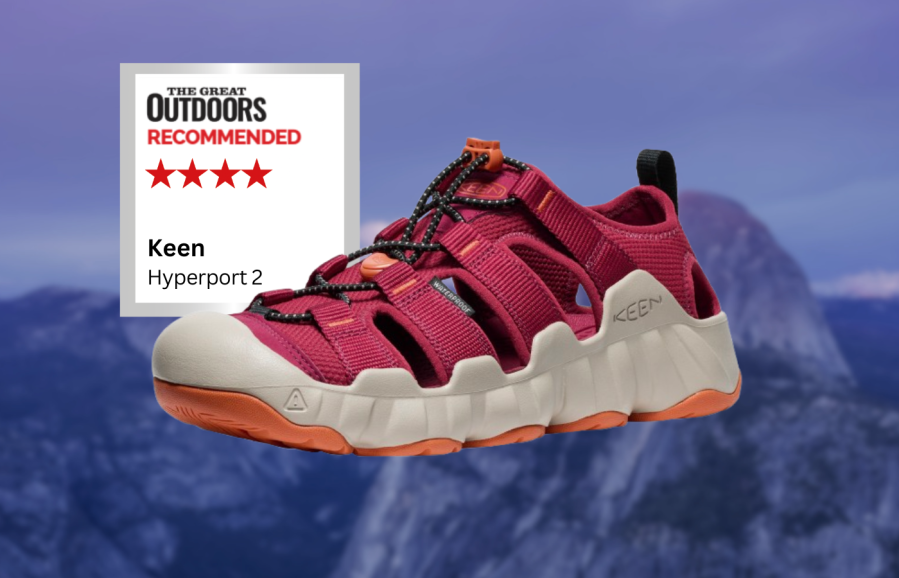
Chris Townsend recommends
In these sandals, the protection means you can kick rocks, should you wish to!- Closed toe
- Cushioning
- Cinch lace
- Shallow tread
| Quick Specs | |
|---|---|
| Price: $126 / £95 Weight: 652g (UK size 9) Materials: Polyester webbing, stretch mesh, injected foam midsole, Aquagrip rubber outsole, bungee lacing Features: Closed toe, quick-cinch lacing, Eco Anti-odour treatment, PFAS-free durable water Repellency Heel-to-toe drop: 15mm Lug depth: 2mm Sizes: UK men 6-14, women 2.5 – 8.5 Women/Mens version: Yes keenfootwear.co.uk |
The Keen Hyperport 2 is really a cross between a sandal and a trail shoe. It has a closed toe and lacing. Fill in the cutouts at the sides and heel and it would be a shoe. As it is, it has some of the advantages of both. Most significant is the closed toe, which provides good protection unlike open-toe sandals. It’s the familiar Keen toe with a thick bumper, similar to those found on the brand’s boots. You can kick rocks, should you wish to! The uppers are made of stretch fabric reinforced with webbing and have an anti-odour treatment.
The stretchy lace can be easily adjusted with a cord lock. Because there’s far more fabric around your foot than with conventional sandals, they can get slightly sweaty in hot weather. I haven’t found that a big problem though. The cushioning is thick and soft and gives good protection.
Read more: Chris’ full review of the Keen Hyperport 2 sandal
Lizard Ultra Trek

Kirsty Pallas’ verdict
While I did feel like there was more protection, it definitely came at the expense of comfort and natural movement for my feet.- Good protection
- Good coverage
- Hard to get on
- Long for size
| Quick Specs | |
|---|---|
| Price: $173 / £130 Weight: 470g (UK size 5) Materials: Upper – thermoplastic polyurethane, Midsole – ethylene vinyl acetate, Outsole – Vibram ECO step, Footbed – recycled moulded EVA Features: Original lug design, cord lock webbing closure, mesh upper, moulded footbed Heel-to-toe drop: 8mm Lug depth: 3mm Waterproof: No Sizes: UK 2.5-8 including half sizes, EU 35-42 Women/Mens version: Yes lizardfootwear.com |
The Lizard Ultra Trek sandal is designed with full days on mixed terrain in mind, and is the only closed toe sandal I tested. A lot of the features make it feel more like a shoe with just a few cut outs, and some mesh. The toe box and sides feel reinforced and stiffer, which offers protection and meant I didn’t stub my toe or get spiked by anything. However, when walking on gravelly beaches or river banks, some stones would sneak in the sides but then not find a way back out without removing the sandal. The tread is angled and grippy on rock and softer ground, with a smoother area on the toe and heel for more scrambling terrain.
The footbed is cushioned and comfortable, but I found it quite warm without the airflow of an open toe sandal. There’s arch support and a slight rise around the whole footbed to keep your foot in place and not sliding around too much. The strap adjustment is a toggled piece of cord that is attached at seven points, and can bring the sides and heel areas in to hug your foot. I have quite a wide foot though, and so I had to work hard to wriggle my foot in even with the toggle as loose as it could go.
Read more: Kirsty’s full review of the Lizard Ultra Trek sandals
Merrell Kahuna III

Chris Townsend’s verdict
The Kahunas perform fine. I found them supportive and comfortable. I just think they are over-designed.- Vibram sole
- Limited adjustability
- Fussy front closure
| Quick Specs | |
|---|---|
| Price: $133 / £100 Weight: 660g (UK size 9) Materials: Pig suede upper, Lycra neoprene lining, Vibram Chameleon Sport Sandal Sole/rubber Features: External TPU heel stability arm, air cushion in the heel Heel-to-toe drop: 15mm Lug depth: 4mm Sizes: UK men 6-14, women 3-8 Women/Mens version: Yes merrell.com |
Merrell has been making excellent sandals for many years. However, I think the Kahuna III is unnecessarily complex – not a word usually associated with sandals. It’s a two-strap open-toe sandal with a little more foot covering than in similar models. The rear heel and ankle strap is connected to the front strap with suede straps, which I don’t think are necessary, but the front strap arrangement is more fussy. This closes with both hook and loop and a clip buckle.
It also has stretch neoprene underneath that wraps over the foot. I found the latter held my foot firmly enough that I didn’t need the buckle or hook and loop. That’s probably because of my wide feet. Those with slim feet may well need the strap as well. Even so, I don’t think it needs two fastening methods. And if you need the strap then you don’t need the neoprene panel.
Read more: Chris’ full review of the Merrell Kahuna III sandals
How we test
Chris wears a UK size 9, has a wide forefoot and a narrower heel. He tested the sandals in the woods and heather moors of the Eastern Cairngorms in autumn 2024 and spring 2025. Weights, lug depth and heel to toe drop were measured by Chris.
Kirsty tested these across Scotland and also in Portugal while hiking, bikepacking, and accessing climbs. Mostly in dry and warm weather, but it often included river crossings or being near the sea. She is a UK women’s size 5 with a broad forefoot. All weights taken from her own scales.
This comparative review was first published in the July 2025 issue of The Great Outdoors.
Are hiking sandals a good idea?
I’ve had good and bad days in sandals. Generally the bad days are the ones that are wet; when I’ve misjudged the conditions and ended up with mud squelching through my toes and a soiled backside after slipping over on a hill. The good days are the ones that have been hot, dry and dusty, when I’ve been glad to have the ventilation, the light footedness and also the ability to cool my feet off in water without having to stop to undo my laces and remove my socks.
So, if the weather is looking set to be hot and dry, sandals can be a very good option for hiking. That is, however, on the condition that the terrain will be suitable enough for the sandals you have. If you’re taking on a hike that involves rocky scrambles then sandals aren’t going to be a good idea. But if most of the hike is on defined trails, a good pair of hiking sandals will normally be ideal for the job.
For long-distance trekking, sandals can sometimes be suitable, though you do need to be certain that the conditions will be warm and dry for the duration of your trek. My sister once asked me for advice on what footwear she should hike in on the Camino de Santiago pilgrimage through Spain. As she was hiking in July I suggested that sandals would be the best bet in the hot conditions she could expect. She ended up slating me for that advice because on her first day of hiking in the mountains it rained heavily, her feet were sliding all over the place and she had to purchase a pair of replacement trail shoes at the first available opportunity.
One solution if you want to have hiking sandals with you for any hot days on a long distance trek is to have a pair that are light enough to store in your pack, ready to be called upon when the right conditions come along.
What to look for when choosing hiking sandals
When choosing hiking sandals, I find that it’s essential to first and foremost consider factors that will ensure comfort, support when taking on varied terrain. Specifically, pay attention to the straps and adjustment mechanisms, as they play a crucial role in providing a secure and comfortable fit. Here are some things to look out for:
Material
It’s a good idea to look for hiking sandals with straps that are made from durable and quick-drying materials like nylon, polyester, or webbing. These materials should be resistant to wear and tear, as well as capable of handling exposure to water and rough terrain.
Leather can be a good material for sandals due to its comfort, durability, breathability, and classic style, making it a versatile option for various occasions. However, leather sandals may not be entirely waterproof and require proper maintenance. They are generally more expensive than synthetic options too and are not suitable for individuals with vegan preferences.
Straps
Look for hiking sandals with multiple adjustable straps that will allow you to customize the fit according to the shape of your foot. Most hiking sandals have straps around the forefoot, instep, and ankle.
I like velcro closures as they are quick and convenient. Buckles tend to be a bit more secure but a bit more fiddly. Some sandals use a combination of both for a customizable fit. You also find some sandals, particularly those from Keen, that use a bungee cord. I like these as they can give a shoe-lacing style fit.
Hiking sandals with support, protection and comfort
Adequate padding around the straps can help prevent chafing and blisters. Additionally, a soft lining on the inner part of the straps can enhance comfort, especially during long hikes. I particular like sandals that have a neoprene lining as I find this prevents the straps from starting to niggle and feeling sore.
I personally like to look for hiking sandals with some level of arch support as it helps reduce foot fatigue and provides better stability during hikes. That said, I know there are people who prefer a more natural ‘barefoot’ feel.
Some hiking sandals come with toe guards or reinforced rubber at the front to protect your toes from rocks and debris. This is particularly beneficial on rugged trails. The downside to these types of sandals is that they tend to be quite heavy and your toes can feel a bit clammier in them than they obviously would in open toe sandals.
Water-friendly features
If you plan to hike in wet environments or encounter water crossings or you want a pair of sandals that you can also use for water sports like kayaking and paddleboarding, choose sandals that dry quickly and have water-friendly properties. Avoid materials that retain water for an extended period, as this can cause discomfort and blisters.
Grip
Grip is so important when it comes to choosing a pair of sandals and not just the outsole grip but the grip to the footbed. I always opt for sandals that have a footbed that my feet will stick to in dry and wet conditions. EVA foam tends to be a good, reliable material for a footbed and if it’s patterned then all-the-better.
As for the grip underfoot, look for sandals that have lugs that are nice and deep – ideally around about 3mm or a little bit more. The rubber compound used is important too – a nice sticky compound will grab to hard and slippery surfaces well. The downside to sticky compounds is that they can mark some surfaces – like hard wood flooring. Who cares about that though. We’re outdoorsy types – we don’t give a hoot about footwear for the indoors!

